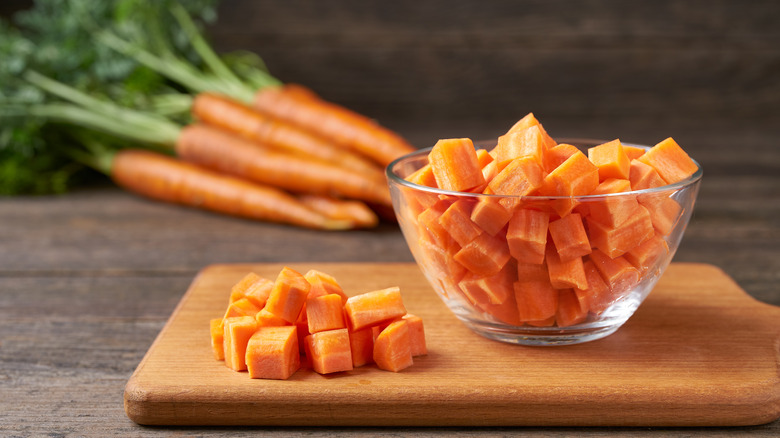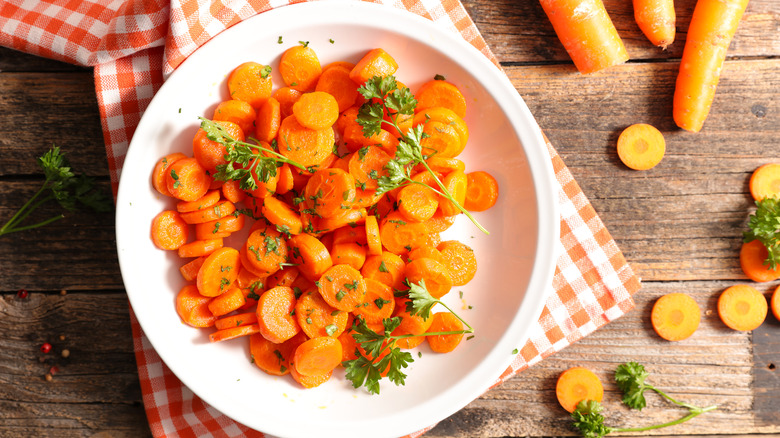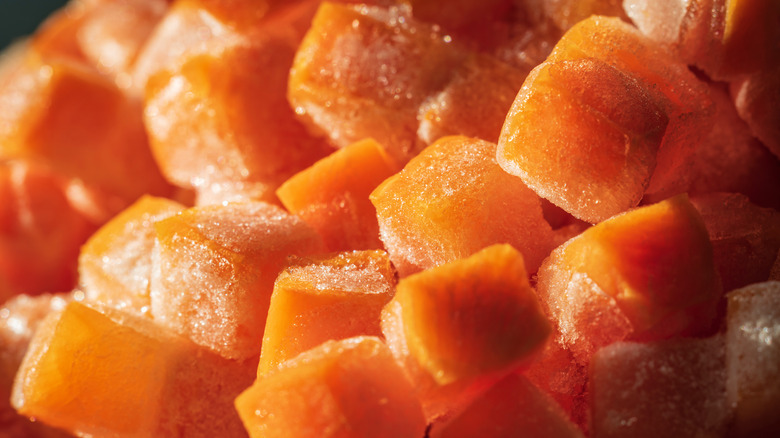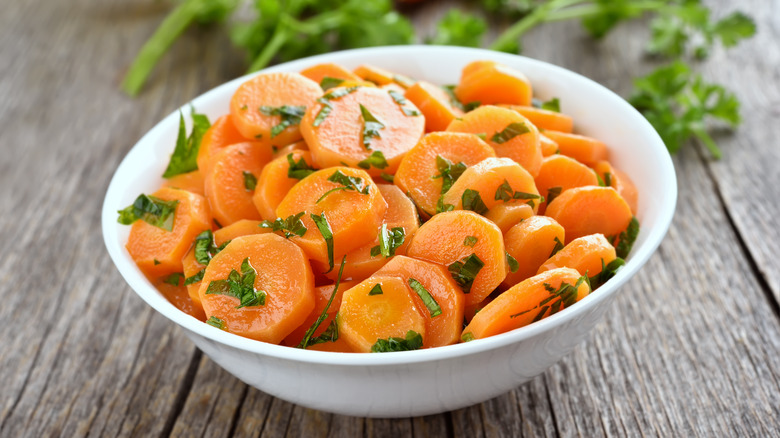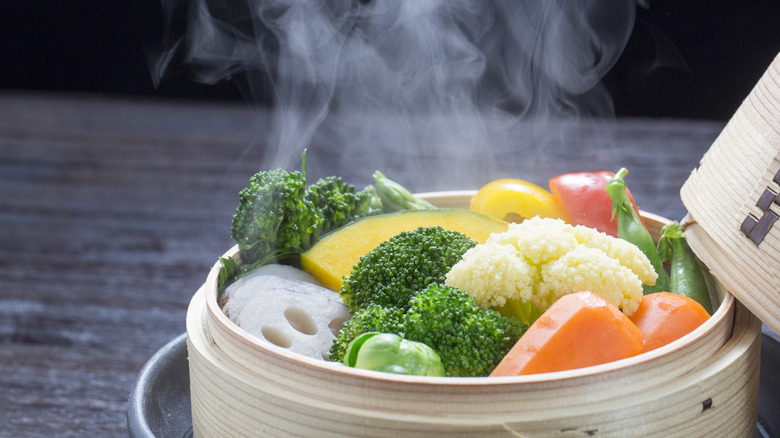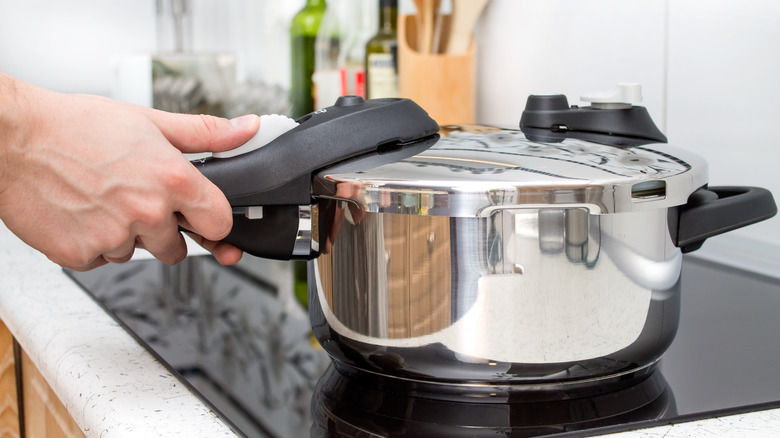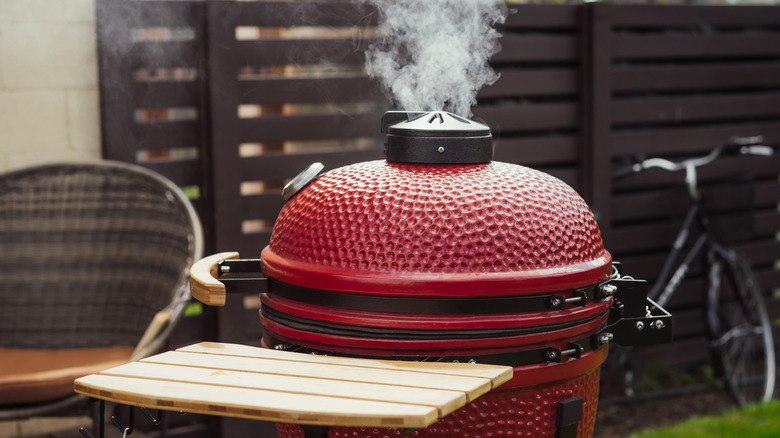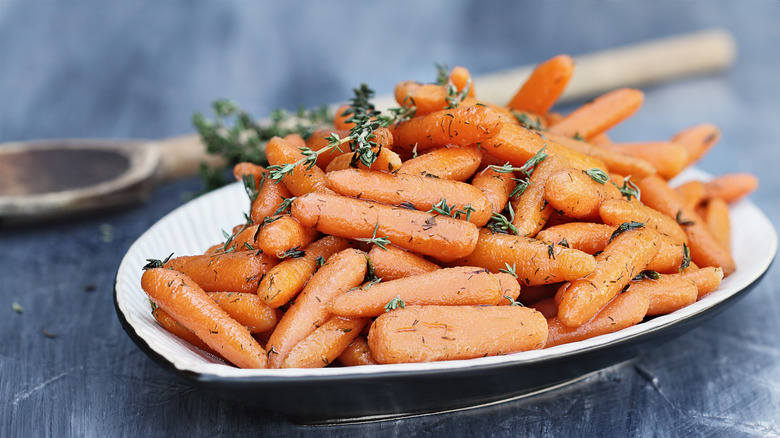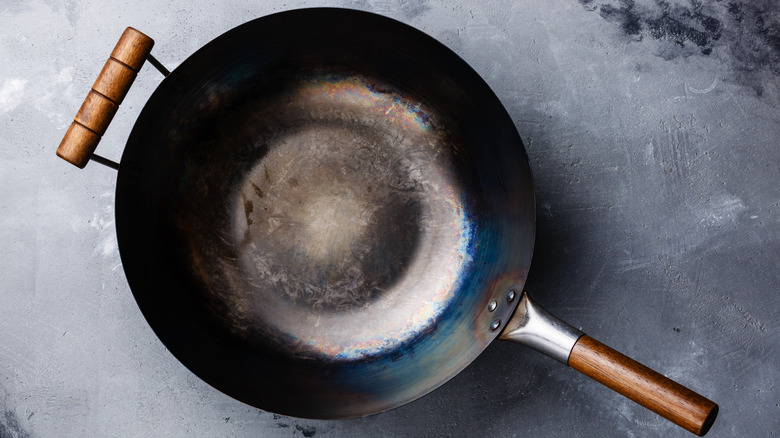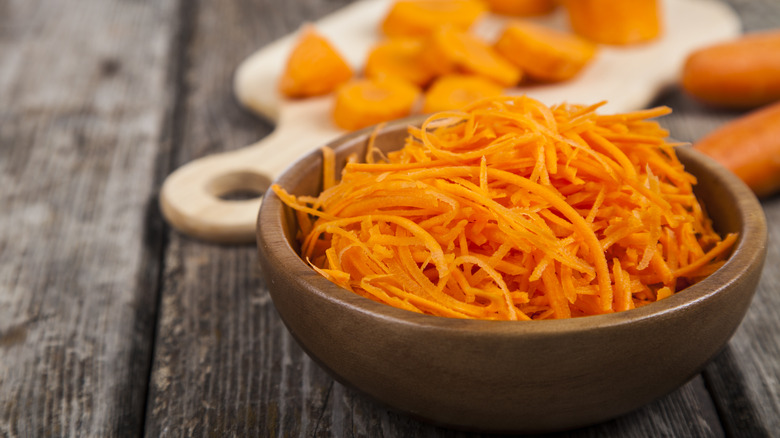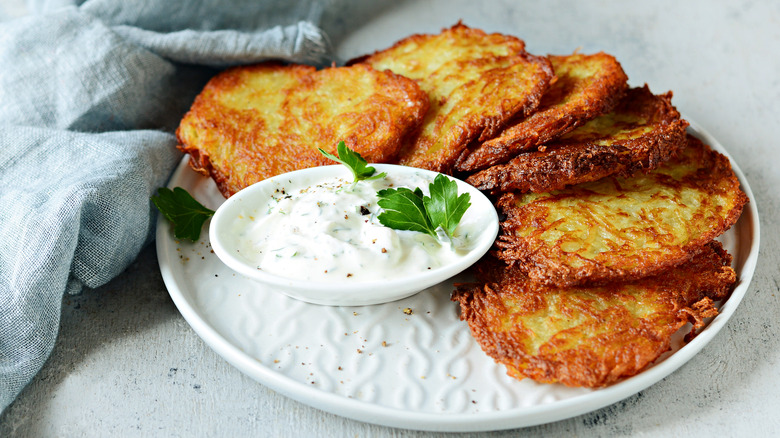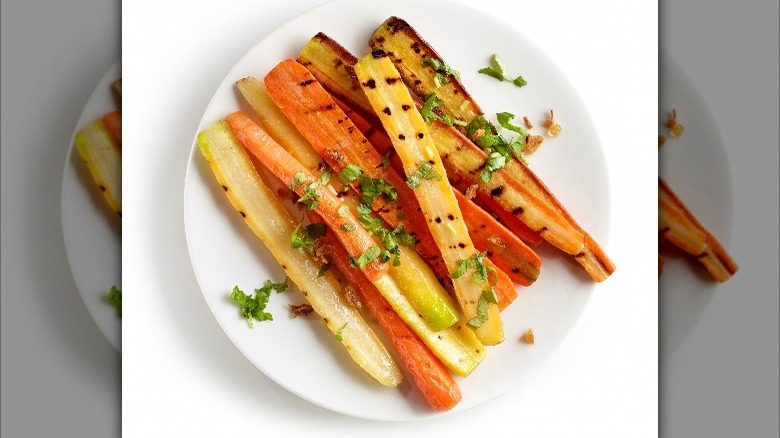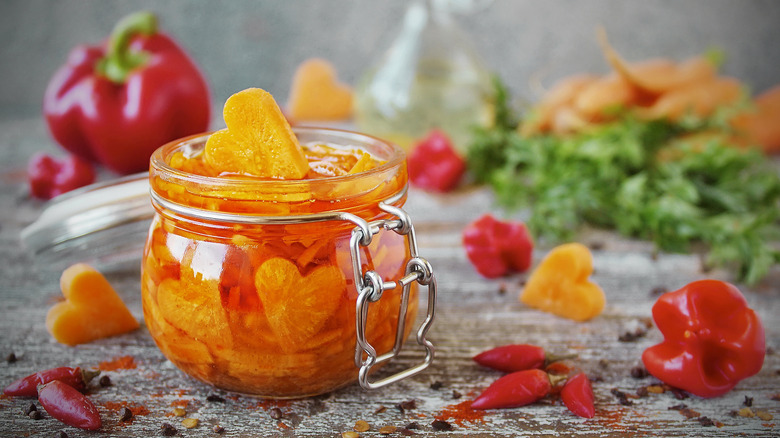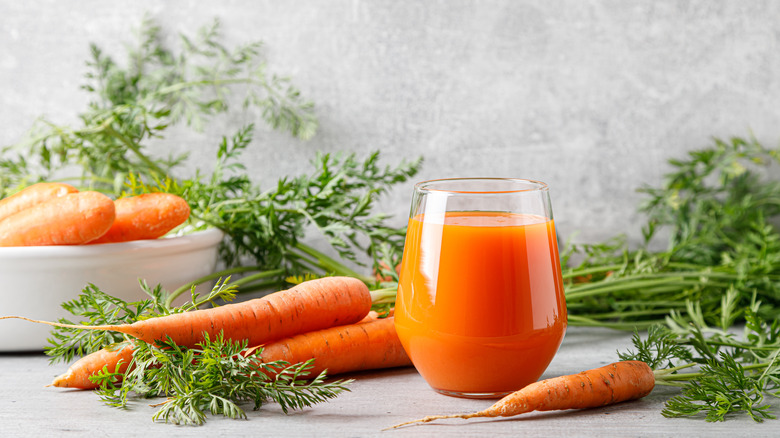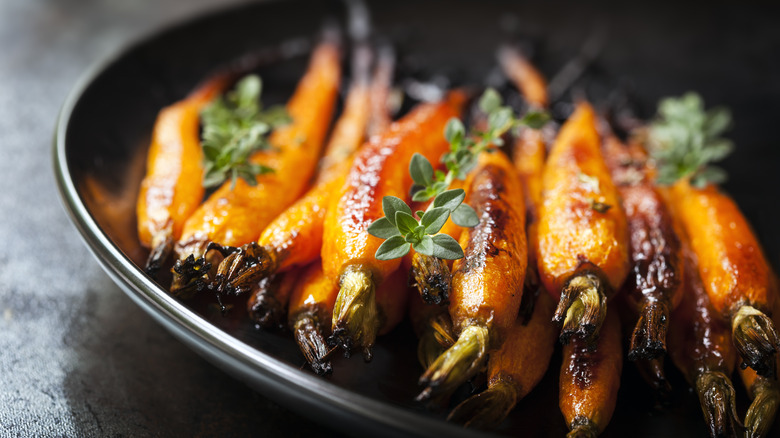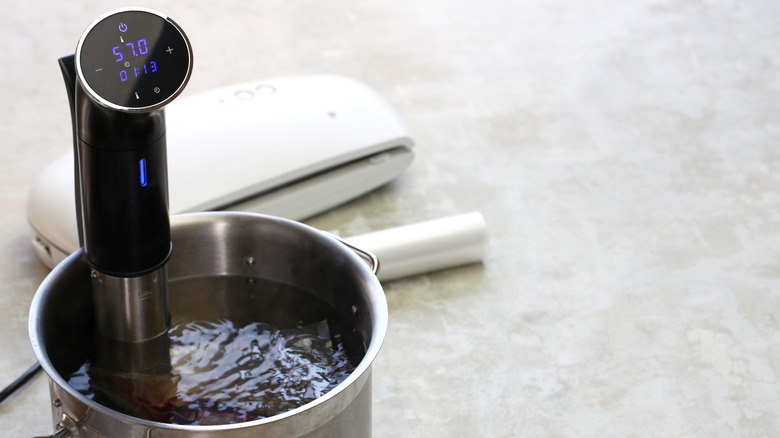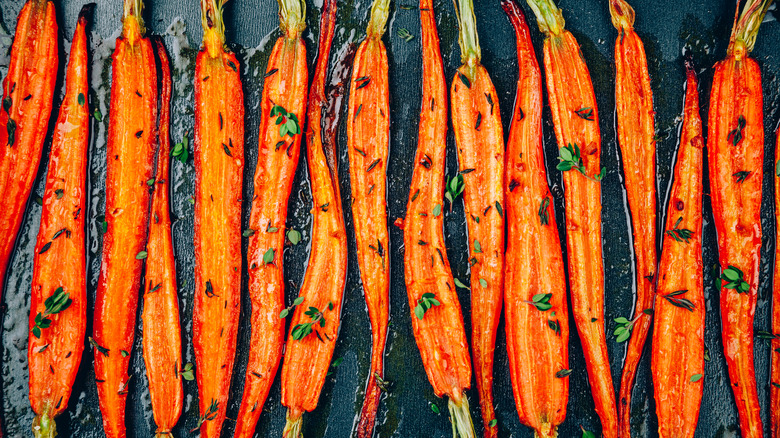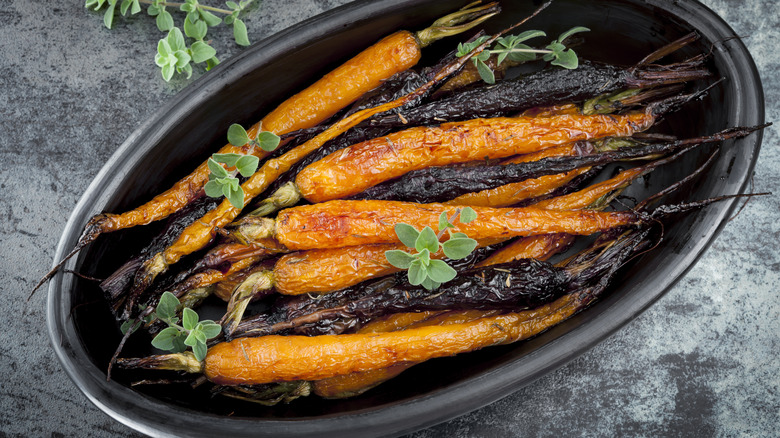Every Method Of Cooking Carrots, Ranked Worst To Best
Superfood vegetables like kale, Brussels sprouts, and multi-colored cauliflower are having their time in the spotlight, but you still don't really hear about carrots. They're one of those vegetables that's easy to overlook because of their staple use in stews, soups, and anything that starts with French mirepoix (a combination of onions, carrots, and celery). It's too bad, because there's a whole world of carrots outside the typical orange cultivar. Carrots can range in color and size, displaying vibrant purple, red, white, and yellow colors that shine in both aesthetics and flavor.
The good news is carrots might be having their moment. Several viral TikTok recipes have featured this sweet vegetable's versatility, transforming shaved carrots into carrot bacon and turning the whole tuber into carrot hot dogs (aka not dogs). So it's time to shine a light on this vegetable, examining the best way to cook carrots to ensure they don't turn out lifeless and dull. We followed the advice of a professional chef to rank every method of cooking carrots, from worst to best.
17. Boiled
If there's one carrot cooking method you should really avoid, it's boiling carrots. You might be tempted to boil carrots to soften the tough tubers for blending into soups, turning into baby food, or serving as a puree. But boiling carrots removes water-soluble vitamins like vitamin C and B vitamins like thiamine and niacin (via Healthline), reducing their nutritional content. Unless you plan to drink the boiling water, a large percentage of those vitamins will be lost in the cooking process.
It's not just about nutrition, either. The bottom line is that boiled carrots are boring and bland. Other cooking methods can be used to soften the vegetable without reducing its flavor, like blanching or steaming carrots until they're tender-crisp. So, all in all, we really just don't recommend this cooking method
16. Blanched
There is a subtle difference between boiling and blanching, and it has to do with the amount of time that the carrots spend in hot liquid. Blanched vegetables only stay in the water long enough to halt enzyme activity, setting the color and reducing spoilage over time without cooking it through. That's important when freezing vegetables, but it's also helpful when adding raw vegetables to salads or crudite platters. The veggies look better when they're blanched.
When it comes to carrots, though, the color difference is negligible and it doesn't do much to improve the carrot's flavor. Blanching is great if you're freezing the carrots, and it's also one of the ways to remove that weird white stuff you see on baby carrots, if that kind of thing bothers you. But when it comes to serving carrots on salads or crudite plates, you can probably skip this step.
15. Microwaved
The microwave is convenient, and it might be an acceptable way to steam carrots that you're planning to puree into a soup. However, this method isn't our top choice when it comes to cooking carrots for a side dish that stands out. The carrots turn out with a lackluster, limp texture, and they just don't taste that great.
Some types of food do better in the microwave than others, with fatty foods lending themselves better than lean ingredients like carrots. That's because the microwaves emitted by this appliance are absorbed by the food, resulting in vibrations between the water and oils to create friction or heat. Fatty foods have more oils than water (and vegetables have more water than oil). Oils heat up more rapidly in a microwave, helping the food cook more quickly.
Not only that, but NPR cautions that carrots contain trace minerals from the soil they grow in, which could lead to the creation of sparks inside the microwave. They may even explode!
14. Steamed
Steamed carrots are a step up from boiled carrots, but they're still not one of our favorite cooking methods. The main reason to steam vegetables is from a health perspective. According to SFGate, steaming carrots prevents nutrient loss, increasing your intake of vitamin A, vitamin K, and potassium. Steaming carrots is also a low-fat cooking method, as no additional oil is required to transform the carrot into a softened bite.
Like boiled carrots, steamed carrots are just a little boring. They have a livelier color and more of a tender-crisp bite, but they need to be spruced up to make them enjoyable. If this is your go-to method of cooking vegetables, try tossing steamed carrots with fresh herbs or combining them with a flavorful dressing to make a side dish like copper penny carrots.
13. Pressure cooked
Electric pressure cookers like the Instant Pot have certainly made life easier, cutting down long cooking times by increasing the pressure (and, therefore, heat) inside the pot. Unfortunately, the Instant Pot requires a minimum amount of liquid to function. According to Zane's Law, the pressure inside pressure cookers can build up to a dangerous level when they don't have enough water, leading to a potential explosion where the lid and food inside could be thrown around your kitchen.
What does that mean for cooking carrots? You'll have to either blanch, boil, or steam carrots if you're using the Instant Pot. Since these are some of our least favorite cooking methods, that means that pressure-cooked carrots also fall to the bottom of our list.
12. Smoked
A good smoker is essential to making great barbecue, but you don't usually see a lot of vegetables used in this type of cuisine. A smoker's low-and-slow cooking temperature is ideal for transforming tough cuts of meat (like brisket or pork shoulder) into tender bites. That's because the connective tissue in a brisket needs time to break down into collagen, but vegetables like carrots don't contain these compounds and don't require the same cooking conditions.
While you can smoke carrots, we wouldn't include them in our top list of vegetables to smoke. Carrots benefit from higher roasting temperatures than you can achieve on a smoker, and cooking them at lower temperatures (like 250 degrees F) can result in carrots that still taste raw despite being cooked through. If you're looking to add smoky flavor to your carrots, we recommend using an ingredient like liquid smoke instead.
11. Braised
Braising is another technique that's classically used with tough cuts of meat, turning a hunk of meat into a delectable pot roast dinner. The same concept that works for smoking is at play here, with connective tissue breaking down over long cooking times. Braising can be done in a Dutch oven, but you can also use a slow cooker to make it happen.
The biggest disadvantage to braising vegetables like carrots is related to texture. The vegetable will become soft and silken, and it will soak up the braising liquid to infuse it with extra flavor, but it will also basically turn to mush. That may not be a bad thing depending on how you're serving the carrots — braised carrots make a great accompaniment to braised meats — but they certainly won't shine with a tender-crisp texture.
10. Stir-fried
We've officially turned the corner from carrot cooking methods that are just okay to ones that turn out pretty fantastic. Stir-fried carrots are one of our favorite ways to prepare the vegetable, as the high heat softens the carrot's crunchy bite without destroying its texture. The classic way to stir-fry is in a wok, but you can also saute carrots in a cast-iron pan. We recommend avoiding nonstick pans, as this cooking method requires high heat, and nonstick pans can release toxic fumes when heated above 500 degrees F.
When making a vegetable stir-fry, it's important to remember to cut the carrots into uniform pieces. If the sliced or diced carrots vary in size, they will also vary in cooking time, leading to some carrots being overdone while others are still raw inside.
9. Shredded
While shredding carrots isn't technically a cooking method, it's a surprisingly delicious way to enjoy carrots. Shredded carrots are typically added to coleslaw mix, but they can also be used to make a carrot slaw that prioritizes the orange vegetable over cabbage.
Raw carrot salads became the focus of everyone's attention in early 2022 with a viral TikTok video with over 2 million views and counting. The TikToker shreds carrots using a vegetable peeler before tossing them with apple cider vinegar, coconut oil, a pinch of salt, red pepper flakes, and black pepper. We tried the salad for ourselves and can solidly rank this "cooking" method as a winner. It minimized the crunch from raw carrots to make them easier to eat, and the vinegar brought out the carrot's natural sweetness.
8. Fried
It might sound odd to fry carrots, but bear with us because it's actually one of the better methods of cooking them. You can pan-fry carrots in a pan with a few tablespoons of oil, keeping the carrot's healthy character while still achieving crispy edges. Frying achieves similar roasty flavors as roasted carrots, but you don't have to wait for the oven to preheat (and it won't heat up your house as much in the summer, either).
Cut carrots in half lengthwise and cook them in hot oil, or cut them into smaller sticks so they look like french fries. Another popular way to fry carrots is by making fritters, which you may know as potato pancakes or latkes — and it turns out carrots are a great latke alternative. Grate the carrots on a box grater and make 100% carrot pancakes, or toss them with other grated vegetables like potatoes, sweet potatoes, parsnips, beets, or turnips.
7. Grilled
We love using the grill for cooking vegetables because it exposes them to direct flame, creating char and adding an extra layer of flavor. This is especially true if you're cooking carrots on a charcoal grill, which will infuse the veggie with an element of smoky character.
The easiest way to grill carrots is when they're left whole or cut in half lengthwise. You'll run the risk of losing the carrots between the grill grate if you cut them into small pieces (although you could use aluminum foil or a grill basket if you've already chopped the carrots). The direct and high heat will cook the carrots to a more crisp texture than a tender one, so you may want to take Alex Guarnaschelli's advice and par-cook the carrots before hitting the grill for a softer bite.
6. Pickled
There are several different types of pickles, and they usually refer to ways to preserve cucumbers. That doesn't mean that all pickles are cucumbers, though, and pickling carrots is a fantastic way to transform the carrot's naturally sweet flavor into a tangier, more complex eating experience. They make a fantastic addition to sandwiches or tacos, but they can also be eaten out of hand.
Making pickled carrots is as easy as heating vinegar, water, and spices before pouring the mixture over sliced carrots. The hot pickling liquid lightly softens the carrots while allowing them to maintain their crunchy bite. We highly recommend adding some sliced jalapenos to the jar to give the carrots a spicy kick. Homemade pickled carrots will last about a month in the refrigerator, or longer if you process them in hot water.
5. Juiced
Okay, you might disagree with us here because juicing is not technically a cooking method, but you may change your mind after you read our advice. It's easy to fall in love with the flavor of juiced carrots. On its own, this juice is a sweet drink that can be enjoyed alone or mixed with smoothies, but it's also a way to transform a carrot into two separate cooking ingredients: carrot juice and carrot pulp.
Add carrot juice to cooking grains like quinoa or couscous to infuse them with sweet-earthy flavors. Or use it as the poaching liquid for chicken or fish to add incredible depth to cooked meats. The pulp is equally useful, and adding carrot pulp to your pasta sauce gives the sauce a thicker texture and an almost cheesy flavor.
4. Glazed
One of the best methods of cooking carrots is a classic one: glazed carrots. This side dish has been prominently featured at holiday meals and fancy dinner parties for decades because it enhances the carrot's flavor, bringing out the sweet vibes and making it taste like it was freshly harvested.
Making glazed carrots is strikingly simple, too. The cut carrots can be tossed with the glaze before being roasted in a 400-degree F oven, or they can be made on the stovetop in a saute pan. Several variations exist, making the glaze with cooking fat and sugar or swapping out the sugar for brown sugar, honey, or agave syrup. When it comes to cooking fats, butter is the classic choice, but heart-healthy recipes use olive oil. We don't recommend neutral oils like vegetable oil, as the flavor from fats like butter, coconut oil, peanut oil, or olive oil makes a difference.
3. Sous vide
If you want your carrots to be perfectly cooked and contain the most carrot-forward flavor, you'll want to invest in the technology to cook carrots with sous vide. Sous vide means "under vacuum," referring to the bag used to seal the ingredients before they're dropped into a water bath. The air is removed from the bag before it's sealed, and the water is kept at a precise cooking temperature.
When it comes to sous vide carrots, this technique works because the carrots reabsorb their own juices as they cook, resulting in a more carroty flavor and a perfect fork-tender texture. When the carrots are finished in the sous vide, you can dump the bag into a saute pan and give them a quick glaze in a saute pan to give them a glossy finish.
2. Air fried
The runner-up to our top carrot-cooking method uses the air fryer, one of our favorite tabletop appliances. Air fryers are basically mini convection ovens that feature a fan to circulate hot air around cooking food. That means you can cook with less oil than other cooking methods while still achieving a similar level of crispness as a deep-fryer.
To get the most success from air-fried carrots, start by preheating the air fryer, making sure that the carrots are cut to similar sizes, and placing them in the basket in a single layer so they cook evenly. Give the carrots a quick spray with cooking oil and get ready to enjoy some of the best carrots you've ever had. It's best to use high-heat (400 degrees F) temperatures when making dishes like air-fryer carrot fries to create the crispiest exterior.
1. Roasted
Our top method for cooking carrots is by roasting them in a high-temperature oven. Roasting vegetables adds a similar level of depth as the grill, lightly charring the edges to create a crisp bite and a caramelized flavor. Unlike the grill's direct heat, the vegetables don't have direct access to the flame so they won't burn before they cook through, thanks to the oven's dry heat environment that creates even heat.
Carrots can be roasted whole, halved, cut into small sticks, sliced into coins, or diced into small bites. Like other cooking methods on this list, keep in mind that they'll need to be uniform in size, or some pieces will cook faster than others. You'll also want to use plenty of oil when roasting carrots, as cooking fat promotes browning and caramelization.
